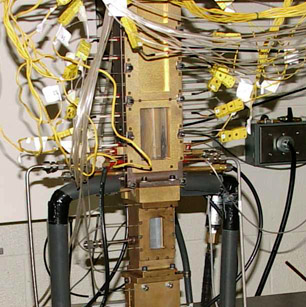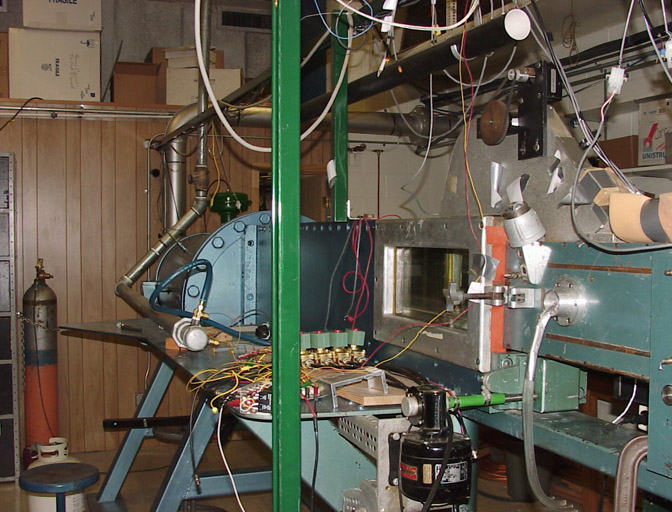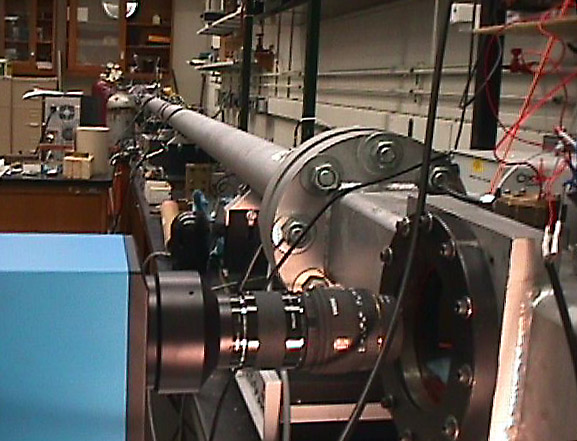Facilities
Hypersonic
Research Facility

 This novel facility incorporates a first, electrical (hence non-vitiated),
heating stage to 1200K and a second stage based on hydrogen combustion to
1850K. Hence, flight enthalpies to
Mach 6 can be simulated. Based on
the existing air supply it can operate with 3.5 lb/s
continuously. Designed by experts
from CIAM, Moscow, Russia, the electric heater has no pressure vessel, hence is
capable of abrupt temperature changes with rates up to 5 K/s, thus enabling
transients.
This novel facility incorporates a first, electrical (hence non-vitiated),
heating stage to 1200K and a second stage based on hydrogen combustion to
1850K. Hence, flight enthalpies to
Mach 6 can be simulated. Based on
the existing air supply it can operate with 3.5 lb/s
continuously. Designed by experts
from CIAM, Moscow, Russia, the electric heater has no pressure vessel, hence is
capable of abrupt temperature changes with rates up to 5 K/s, thus enabling
transients.
More information,
including examples of possible test section sizes for both internal and
external flow simulation, is given here.
Supersonic
combustion tunnel – vitiated
 The
vitiated Mach 4.7 enthalpy tunnel complements the new hypersonic facility (described separately). It has been used for supersonic
combustion of hydrogen and/or liquid and gaseous hydrocarbon fuels at isolator
Mach numbers ranging from 1.3 to 3.6. The 1 x 1 in. (2.5x2.5 cm) cross section
test-section is instrumented with pressure ports and thermocouples and has
ample optical access via quartz windows for visualization and laser-based
diagnostics. Different injection schemes have been used for studies of
flameholding or injection/mixing analyses.
For liquid fuels, a separate heater is available to raise the fuel
temperature up to 550K.
Compressors output continuously up to 3.5 lb/s
(1.6 kg/s) with stagnation pressures up to 200 psia
(1.4 MPa).
The
vitiated Mach 4.7 enthalpy tunnel complements the new hypersonic facility (described separately). It has been used for supersonic
combustion of hydrogen and/or liquid and gaseous hydrocarbon fuels at isolator
Mach numbers ranging from 1.3 to 3.6. The 1 x 1 in. (2.5x2.5 cm) cross section
test-section is instrumented with pressure ports and thermocouples and has
ample optical access via quartz windows for visualization and laser-based
diagnostics. Different injection schemes have been used for studies of
flameholding or injection/mixing analyses.
For liquid fuels, a separate heater is available to raise the fuel
temperature up to 550K.
Compressors output continuously up to 3.5 lb/s
(1.6 kg/s) with stagnation pressures up to 200 psia
(1.4 MPa).
High-pressure
combustion chamber
 This 1” x1”
(2.5x2.5 cm) cross section test chamber has been used for studies of conjugate species concentration/wall heat transfer for mixtures of
hydrogen-oxygen and hydrogen-air combustion at elevated pressures up to 900 psi
(6 MPa).
A coaxial injector of 75% the size of the main shuttle engine has been
used to date. A study of OH PLIF
measurements uncertainty evaluated 18 parameter concluding that the largest
sources of error derive from uncertain local temperature (up to 15%) and laser
shot-to-shot (up to 11%).
This 1” x1”
(2.5x2.5 cm) cross section test chamber has been used for studies of conjugate species concentration/wall heat transfer for mixtures of
hydrogen-oxygen and hydrogen-air combustion at elevated pressures up to 900 psi
(6 MPa).
A coaxial injector of 75% the size of the main shuttle engine has been
used to date. A study of OH PLIF
measurements uncertainty evaluated 18 parameter concluding that the largest
sources of error derive from uncertain local temperature (up to 15%) and laser
shot-to-shot (up to 11%).
High-Pressure
Chamber for Supercritical Studies
 This facility is used for
studies of subcritical-to-supercritical jet disintegration and mixing. It is 9 inch (230 mm) long and has a
1.8” x 1.8” (46x46 mm) inner cross-section. Optical access is provided
through four symmetrically located, 3.3” x 0.9” (84x22 mm) fused
silica windows. The chamber can be pressurized up to 1030 psi (7 MPa) at 620K.
The injected liquid is pre-heated independently up to 675 K. Using a fluoroketone, current studies
focus on subcritical to supercritical jet disintegration in single and dual
species compounds, with chamber environment from subcritical to
supercritical. These conditions
appear in a broad range of applications ranging from rocket to diesel to
scramjet engines.
This facility is used for
studies of subcritical-to-supercritical jet disintegration and mixing. It is 9 inch (230 mm) long and has a
1.8” x 1.8” (46x46 mm) inner cross-section. Optical access is provided
through four symmetrically located, 3.3” x 0.9” (84x22 mm) fused
silica windows. The chamber can be pressurized up to 1030 psi (7 MPa) at 620K.
The injected liquid is pre-heated independently up to 675 K. Using a fluoroketone, current studies
focus on subcritical to supercritical jet disintegration in single and dual
species compounds, with chamber environment from subcritical to
supercritical. These conditions
appear in a broad range of applications ranging from rocket to diesel to
scramjet engines.
Catalytic
combustor
This facility consists of two
concentric tubes where the outer surface of the inner tube is covered with a
catalyst. The inner tube contains a cooling air flow while the annular region
contains a fuel-air mixture that reacts on the catalytic surface. The inner and
outer air flows can be independently controlled by a number of massflow controllers from Alicat,
allowing equivalence ratios and fuel composition to be varied over a wide
range. The incoming air streams can also be preheated through passing through
two independently controlled electric heaters, allowing the conditions in a RQL
low-NOx gas turbine pre-combustor to be modeled.
Measurements are carried out using mass spectrometry of gas samples drawn from
above the catalyst surface and through laser-based diagnostics through the
fused-silica windows of the test section.
Cavitation
tunnel
 The cavitation tunnel is
filled with a volatile fluoroketone for studying cavitation under near-critical
conditions. This fluoroketone, like
cryogenics, belongs to a class of fluids with thermosensitive properties;
hence, the fluoroketone – unlike water which is more commonly used - simulates
cavitation modes of cryogenic fluids.
The tunnel is capable of reaching a speed of 33 fps (10 m/s) in its
4” x4” (0.1x0.1 m) cross section test section, enabling high-Re
tests under different angles of attack.
Currently a NACA 0015 hydrofoil is the test object. The tunnel is driven
by a variable-speed 25 hp pump and is fitted with
large windows facilitating the application of optical diagnostics, primarily
PLIF. With a dedicated pulsed Nd:YAG
laser and a rotating-mirror image acquisition system, frame rates of 100-
10,000 Hz are possible. The tunnel is constructed of aluminum and may be
vacuumed or pressurized up to 75 psia (5 bar). It is
equipped with a 7.5kW heater and a chilled water system facilitating the
investigation of both pressure and temperature effects. Furthermore, by lowering the
fluoroketone temperature cavitation modes met in water – the material
used in most studies elsewhere – can be modeled.
The cavitation tunnel is
filled with a volatile fluoroketone for studying cavitation under near-critical
conditions. This fluoroketone, like
cryogenics, belongs to a class of fluids with thermosensitive properties;
hence, the fluoroketone – unlike water which is more commonly used - simulates
cavitation modes of cryogenic fluids.
The tunnel is capable of reaching a speed of 33 fps (10 m/s) in its
4” x4” (0.1x0.1 m) cross section test section, enabling high-Re
tests under different angles of attack.
Currently a NACA 0015 hydrofoil is the test object. The tunnel is driven
by a variable-speed 25 hp pump and is fitted with
large windows facilitating the application of optical diagnostics, primarily
PLIF. With a dedicated pulsed Nd:YAG
laser and a rotating-mirror image acquisition system, frame rates of 100-
10,000 Hz are possible. The tunnel is constructed of aluminum and may be
vacuumed or pressurized up to 75 psia (5 bar). It is
equipped with a 7.5kW heater and a chilled water system facilitating the
investigation of both pressure and temperature effects. Furthermore, by lowering the
fluoroketone temperature cavitation modes met in water – the material
used in most studies elsewhere – can be modeled.
Mach
4 wind tunnel
 The MAE department Mach 1.5-4
wind tunnel has a 6” x 6” inch (15 x15 cm) test section equipped
with a sting with variable angle-of-attack as well as a Schlieren
setup, a PSI9010 pressure scanner and additional pressure transducers. The wind tunnel has access ports for
secondary air injection or bleed.
Using the air storage tanks and high-pressure single-stage screw
compressors, 30 s runs can be carried out approximately every 5 minutes at Mach
3.8. This facility was used most
recently used for tests of fuel injection in supersonic inlets and inlet instabilities for pulse detonation engines.
The MAE department Mach 1.5-4
wind tunnel has a 6” x 6” inch (15 x15 cm) test section equipped
with a sting with variable angle-of-attack as well as a Schlieren
setup, a PSI9010 pressure scanner and additional pressure transducers. The wind tunnel has access ports for
secondary air injection or bleed.
Using the air storage tanks and high-pressure single-stage screw
compressors, 30 s runs can be carried out approximately every 5 minutes at Mach
3.8. This facility was used most
recently used for tests of fuel injection in supersonic inlets and inlet instabilities for pulse detonation engines.
Mach
5 shock tube
 The 4 inch (10 cm) diameter,
double-diaphragm, shock tube generates shocks of up to Mach 5 strength. Two
test sections are available at the end of the 6 m driven section. The
combustion test section, separated by a thin mylar
diaphragm from the driven section, is used to measure ignition delay times of
premixed gases in the range of 800-2400 K using the reflected shock. CH and OH
emissions can be detected by a Hamamatsu R374 photomultiplier using the
appropriate narrowband filters. The second test section has a square cross
section with optical access and is used for studying shock-droplet interactions
and ignition using high-speed cameras.
The 4 inch (10 cm) diameter,
double-diaphragm, shock tube generates shocks of up to Mach 5 strength. Two
test sections are available at the end of the 6 m driven section. The
combustion test section, separated by a thin mylar
diaphragm from the driven section, is used to measure ignition delay times of
premixed gases in the range of 800-2400 K using the reflected shock. CH and OH
emissions can be detected by a Hamamatsu R374 photomultiplier using the
appropriate narrowband filters. The second test section has a square cross
section with optical access and is used for studying shock-droplet interactions
and ignition using high-speed cameras.
Back to the Combustion Lab homepage.